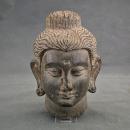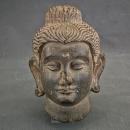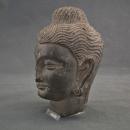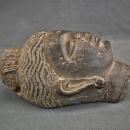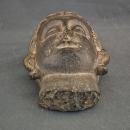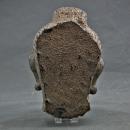Ancient 3rd century A.D. Gray Schist Stone Buddha Head Ancient Region Of Gandhara Kushan Empire








$25,000.00
Ancient, circa 3rd century A.D. Gray schist stone head of Buddha, Ancient region of Gandhara,. Kushan Empire period.
The elegantly carved head in highly polished gray schist with stylized curls drawn up over the ushnisha at crown of head, with a distinctive widow’s peak above the broad forehead and urna, finely chiselled eyebrows curving into the strong aquiline nose, the lowered eyes serene and downcast, with a bow-shaped mouth and pendulous earlobes signifying Buddha’s renunciation, with traces of original stucco overall.
Height 20 cm (7.9 inches).
Under the rule of the Kushans, northwest India and adjoining regions participated both in seagoing trade and in commerce along the Silk Road to China. The name Kushan derives from the Chinese term Guishang, used in historical writings to describe one branch of the Yuezhi—a loose confederation of Indo-European people who had been living in northwestern China until they were driven west by another group, the Xiongnu, in 176–160 B.C. The Yuezhi reached Bactria (northwest Afghanistan and Tajikistan) around 135 B.C. Kujula Kadphises united the disparate tribes in the first century B.C. Gradually wresting control of the area from the Scytho-Parthians, the Yuezhi moved south into the northwest Indian region traditionally known as Gandhara (now parts of Pakistan and Afghanistan) and established a capital near Kabul. They had learned to use a form of the Greek alphabet, and Kujula’s son was the first Indian ruler to strike gold coins in imitation of the Roman aureus exchanged along the caravan routes.
The rule of Kanishka, the third Kushan emperor who flourished from the late first to the early/mid-second century A.D., was administered from two capitals: Purushapura (now Peshawar) near the Khyber Pass, and Mathura in northern India. Under Kanishka’s rule, at the height of the dynasty, Kushan controlled a large territory ranging from the Aral Sea through areas that include present-day Uzbekistan, Afghanistan, and Pakistan into northern India as far east as Benares and as far south as Sanchi. It was also a period of great wealth marked by extensive mercantile activities and a flourishing of urban life, Buddhist thought, and the visual arts.
The Gandhara region at the core of the Kushan empire was home to a multiethnic society tolerant of religious differences. Desirable for its strategic location, with direct access to the overland silk routes and links to the ports on the Arabian Sea, Gandhara had suffered many conquests and had been ruled by the Mauryans s, Alexander the Great (327/26–325/24 B.C.), his Indo-Greek successors (third–second centuries B.C.), and a combination of Scythians and Parthians (second–first centuries B.C.). The melding of peoples produced an eclectic culture, vividly expressed in the visual arts produced during the Kushan period. Themes derived from Greek and Roman mythologies were common initially, while later, Buddhist imagery dominated: some of the first representations of the Buddha in human form date to the Kushan era, as do the earliest depictions of bodhisattvas.
ACCOMPANIED BY CERTIFICATES OF AUTHENTICITY
